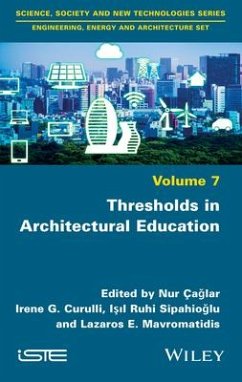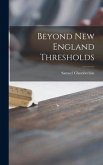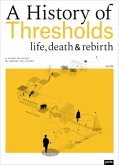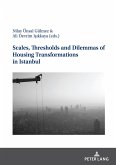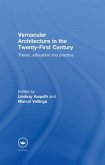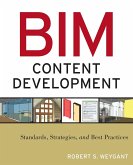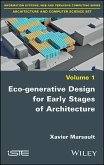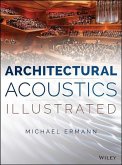Thresholds in Architectural Education
Herausgeber: Caglar, Nur; Mavromatidis, Lazaros; Ruhi Sipahioglu, Isil; Curulli, Irene G
Thresholds in Architectural Education
Herausgeber: Caglar, Nur; Mavromatidis, Lazaros; Ruhi Sipahioglu, Isil; Curulli, Irene G
- Gebundenes Buch
- Merkliste
- Auf die Merkliste
- Bewerten Bewerten
- Teilen
- Produkt teilen
- Produkterinnerung
- Produkterinnerung
The book explores, discusses, and considers new and innovative perspectives on the crossings, interactions, and transformations of non-formal, informal learning, and formal learning within or prior to FADS and Internship. The contributions provide a wider perspective on the alternating Final Architectural Design Studios and Internship programs as interfaces and interaction zones among different learning experiences that lead to professional and intellectual qualification.
Andere Kunden interessierten sich auch für
![Beyond New England Thresholds Beyond New England Thresholds]() Samuel ChamberlainBeyond New England Thresholds31,99 €
Samuel ChamberlainBeyond New England Thresholds31,99 €![A History of Thresholds A History of Thresholds]() Sensual City StudioA History of Thresholds32,00 €
Sensual City StudioA History of Thresholds32,00 €![Scales, Thresholds And Dilemmas Of Housing Transformations In Istanbul Scales, Thresholds And Dilemmas Of Housing Transformations In Istanbul]() Scales, Thresholds And Dilemmas Of Housing Transformations In Istanbul65,85 €
Scales, Thresholds And Dilemmas Of Housing Transformations In Istanbul65,85 €![Vernacular Architecture in the 21st Century Vernacular Architecture in the 21st Century]() Lindsay Asquith / Marcel Vellinga (eds.)Vernacular Architecture in the 21st Century236,99 €
Lindsay Asquith / Marcel Vellinga (eds.)Vernacular Architecture in the 21st Century236,99 €![Bim Content Development Bim Content Development]() Robert S WeygantBim Content Development81,99 €
Robert S WeygantBim Content Development81,99 €![Eco-Generative Design for Early Stages of Architecture Eco-Generative Design for Early Stages of Architecture]() Xavier MarsaultEco-Generative Design for Early Stages of Architecture176,99 €
Xavier MarsaultEco-Generative Design for Early Stages of Architecture176,99 €![Architectural Acoustics Illustrated Architectural Acoustics Illustrated]() Michael ErmannArchitectural Acoustics Illustrated93,99 €
Michael ErmannArchitectural Acoustics Illustrated93,99 €-
-
-
The book explores, discusses, and considers new and innovative perspectives on the crossings, interactions, and transformations of non-formal, informal learning, and formal learning within or prior to FADS and Internship. The contributions provide a wider perspective on the alternating Final Architectural Design Studios and Internship programs as interfaces and interaction zones among different learning experiences that lead to professional and intellectual qualification.
Hinweis: Dieser Artikel kann nur an eine deutsche Lieferadresse ausgeliefert werden.
Hinweis: Dieser Artikel kann nur an eine deutsche Lieferadresse ausgeliefert werden.
Produktdetails
- Produktdetails
- Verlag: Wiley
- Seitenzahl: 304
- Erscheinungstermin: 13. Oktober 2020
- Englisch
- Abmessung: 236mm x 152mm x 23mm
- Gewicht: 748g
- ISBN-13: 9781786306494
- ISBN-10: 1786306492
- Artikelnr.: 59946830
- Herstellerkennzeichnung
- Libri GmbH
- Europaallee 1
- 36244 Bad Hersfeld
- gpsr@libri.de
- Verlag: Wiley
- Seitenzahl: 304
- Erscheinungstermin: 13. Oktober 2020
- Englisch
- Abmessung: 236mm x 152mm x 23mm
- Gewicht: 748g
- ISBN-13: 9781786306494
- ISBN-10: 1786306492
- Artikelnr.: 59946830
- Herstellerkennzeichnung
- Libri GmbH
- Europaallee 1
- 36244 Bad Hersfeld
- gpsr@libri.de
* Tayyibe Nur Çaðlar, Prof. Dr., Head of Department of Architecture, TOBB University of Economics and Technology * Irene G. Curulli, Assist. Prof. Dr., Department of the Built Environment, Architectural Design and Engineering, Eindhoven University of Technology (TU/e) * Iþýl Ruhi-Sipahioðlu, Dr., Lecturer, Department of Architecture, TOBB University of Economics and Technology * Lazaros Mavromatidis, Dr, Associate Professor, School of Architecture, Institut National des Sciences Appliqués Strasbourg (editor in chief of the series)
Introduction xiii Nur ÇA
LAR and Irene G. CURULLI Editors and Contributors xxiii Part 1. Practices in the Formal Institutions that Cope with the Rapid Pace of Change 1 Chapter 1. Towards a New Interaction Between Educational Processes and Practices: Faculty of Architecture, Sapienza University of Rome 3 Anna Maria GIOVENALE, Spartaco PARIS and Roberto BIANCHI 1.1. Framework of reference: between crisis of the figure of the architect and the need for innovation 4 1.2. Newly integrated skills and knowledge for technical training in the field of architecture and of construction engineering 5 1.3. A new opportunity for training and the profession: managing the processes of building design and construction 6 1.4. The new training project and relationship with the professions 10 1.5. References 12 Chapter 2. Continuity in Architectural Education: A Driving Force or a Burden to Creativity? 13 Deniz
NCEDAYI, Burcu Selcen CO
KUN and
kbal Ece POSTALCI 2.1. Introduction 13 2.2. A conventional education method: Mimar Sinan Fine Arts University Department of Architecture 15 2.3. Towards a more inclusive approach 20 2.4. Conclusion 22 2.5. References 23 Chapter 3. From the Experiences in the Iberian Peninsula to California 25 Pedro Ressano GARCIA 3.1. Introduction 25 3.2. The Iberian schools - Porto, Lisbon and Barcelona 26 3.3. Passing by the University of California 26 3.4. Early teaching 28 3.5. References 28 Chapter 4. Project Domain: A Formalist Exercise in the Education of Architects 31 Krunoslav IVANIIN 4.1. The Crystal Palace 31 4.2. The practice and the education of architecture 36 4.3. The sequence 37 4.4. References 42 Chapter 5. Towards a New Studio Culture: Changing Minds, Transforming Education 45 Ozan Önder ÖZENER and Mehmet Ümit METERELLIYÖZ 5.1. Introduction 45 5.2. Thoughts and views on studio culture 47 5.3. Influencers of studio culture 49 5.4. Studio culture and informal learning 50 5.5. Suggestions 53 5.6. Conclusion 54 5.7. References 54 Chapter 6. Climatic Heterotopias or the Obscure Element of Architectural Creation: Introducing a Tangible Alternative Pedagogy within a Global Climate Regime 57 Lazaros MAVROMATIDIS 6.1. Architectural consciousness and pedagogy 57 6.2. Tarrying with multiple imaginaries 59 6.3. Climate change, normative abstract idealisms, constructal thermodynamics and sustainable spatiality 61 6.4. Climatic heterotopias 64 6.5. Once upon a sustainable architectural space 66 6.6. References 67 Chapter 7. A Threshold In-between Education and Profession: The Final Architectural Design Studio 69 I
l RUH
S
PAH
O
LU and Asl
ALANLI 7.1. Introduction 69 7.2. The survey of FADSs across European architecture schools 71 7.2.1. Methodology 72 7.2.2. Objectives of FADSs 76 7.2.3. The duration of FADSs 79 7.2.4. Supervision models 80 7.2.5. Enrollment criteria 81 7.2.6. The appointment of tutors 82 7.2.7. Topic/theme determination 83 7.2.8. Student position 85 7.2.9. Co-requisite courses along FADSs 85 7.2.10. Assessment methods 86 7.2.11. Appointment of jury members 90 7.3. Challenges in the final studio 92 7.3.1. Major challenges faced by students 92 7.3.2. Major challenges faced by teaching staff 93 7.3.3. Strong aspects of the FADS 94 7.4. Conclusion 96 7.5. Acknowledgements 97 7.6. References 97 Chapter 8. Final Diploma Project as a Key into the Architect's Profession 99 Zbigniew W
adys
aw PASZKOWSKI and Anna PAZDUR-CZARNOWSKA 8.1. Architecture and urban planning in the Polish educational system 99 8.2. Integrating and disintegrating trends in the scientific discipline: "architecture and urban planning" 100 8.3. Architecture curriculum in Poland according to the Bologna System 101 8.4. First-degree studies (engineer studies) 102 8.4.1. General requirements 102 8.4.2. Content and effects of education 102 8.4.3. Other requirements 106 8.4.4. Graduate qualifications of first-degree studies (engineer studies) 106 8.5. Second-degree studies 107 8.5.1. General requirements 107 8.5.2. Content and educational effects of the courses 107 8.5.3. Other requirements 108 8.5.4. Graduate qualifications of the second-degree studies (Master studies) 108 8.6. Demands and expected outcomes of the Final Diploma Project (FDP) in architecture and urban planning in Poland 109 8.7. FDP as a key to professional work in architectural and urban planning studios 110 8.8. Discussion on the expectations of the job market and those of the young absolvents of architecture 112 8.9. Benchmarking system for international comparison of professional preparation of absolvents of architecture and urban planning 114 8.10. Conclusion 115 8.11. Appendix 1. The list of Polish state universities and private high education schools with Architecture and Urban Planning 116 8.12. References 117 Chapter 9. Designing a Relevant Answer to One's Own Question: Assessing the Diploma Studio at the Zagreb Faculty of Architecture 119 Mia ROTH-
ERINA 9.1. Introduction 120 9.2. Developing the Zagreb Faculty of Architecture's curricular profile 120 9.3. Extracurricular workshops: exploring motives 121 9.3.1. Social agency: learning spaces in transition workshop 122 9.3.2. Empathy through immersion: mountaineers' shelter workshop 122 9.3.3. Designing meaning: AF/SC workshop 123 9.4. Testing alertness: the diploma studio in Zagreb 124 9.5. Conclusion 126 9.6. References 127 Chapter 10. Designerly Ways of Understanding Research Capabilities of Architectural Design and Studio 129 Zelal ÖZTOPRAK and Nur ÇA
LAR 10.1. Architectural design studio as a research platform 129 10.2. Intricacy of intellectual and actual sources of design experience 131 10.3. Structured improvisation 133 10.4. Emergence of difference through repetition 134 10.5. For example, TOBB ETU Final Architectural Design Studio 135 10.5.1. Manifesto 140 10.5.2. Network strategy 142 10.5.3. Studio Book 142 10.6. Conclusion 143 10.7. Acknowledgements 143 10.8. References 143 Chapter 11. Theory and Practice of Bookmaking: An Experiment in Architectural Design Education 145 Selda BANCI 11.1. Introduction 146 11.2. Book 147 11.3. Making 152 11.4. Conclusion 155 11.5. Acknowledgements 158 11.6. References 158 Chapter 12. Formal Supersedes Non-formal: Comparative Analyses of European and Japanese Architectural Design Education 161 Larisa
II
12.1. Introduction 162 12.2. Methods 162 12.3. Results 162 12.3.1. Final Architectural Design Studio (FADS) 162 12.3.2. Studio/preparation 163 12.3.3. Studio/conduct 164 12.3.4. Studio/assessment 164 12.3.5. Studio/general 165 12.4. Conclusion 165 12.5. References 166 Part 2. Non-formal and Informal Learning Environments 167 Chapter 13. A Tangible Approach to the Alternative Teaching Education 169 Dimitra BABALIS 13.1. Introduction 169 13.2. A review of education and skills for a sustainable educational design. 170 13.3. Expansion in education interest in ecological and sustainable urban design 172 13.4. The Erasmus Intensive Programs (IPs) experience at the University of Florence 173 13.5. Intensive Programs (IPs)/Design Workshops (DWs) educational structure 174 13.6. The Florence IP/DW description 177 13.7. Conclusion 179 13.8. References 180 Chapter 14. Social Networks and Architecture: Possible Benefits for Design Education? 183 Akin Tolga
LTER 14.1. Introduction 183 14.2. Using social media for design studio education 185 14.3. Case studies 186 14.3.1. Case study I: design blog 186 14.3.2. Case study II: social network 189 14.3.3. Case study III: "Insta Company" 191 14.4. Conclusion 194 14.5. References 195 Chapter 15. Architectural Education and the Politics of Architect-Client Relationships: A Case Study from Jordan 197 Ahlam HARAHSHEH 15.1. Introduction 197 15.2. Current pedagogy in selected architectural departments in Jordan 199 15.3. Importance of communication skills in architectural education 201 15.4. Training after graduation 204 15.5. Conclusion 205 15.6. References 206 Chapter 16. Outer Studio: Learning from the Students 209 Çäda TÜRKMEN 16.1. Architectural design education in Turkey 209 16.2. Initiatives of students: architecture, design and education 211 16.2.1. Bayku
lar Toplan
yor (Izmir, 2010-2013) 212 16.2.2. Yer_denyüksek (Istanbul, 2013-2015) 213 16.2.3. Bademlik Tasar
m Festivali (Eski
ehir, 2013-) 213 16.2.4. Ulusal Mimarl
k Ö
rencileri Bulu
mas
(UMÖB) 215 16.3. This will not kill that 217 16.4. References 219 Chapter 17. An International Collaboration and Interdisciplinary Architectural Education Experience: Atelier Européen 221 Elif MIHÇIO
LU 17.1. Introduction 222 17.2. Flexibility in formal-informal integrated architectural education and interdisciplinary collaborations 222 17.3. The case of Atelier Européen 223 17.3.1. Structure, objectives, content and methods 224 17.3.2. Stages of the studio process 225 17.3.3. Previous studio projects 225 17.4. Evaluation 231 17.5. Conclusion 231 17.6. Acknowledgements 232 17.7. References 232 Chapter 18. A School of One's Own: Reporting from the Students' Front 235
kbal Ece POSTALCI, Burcu Selcen CO
KUN and I
l RUH
S
PAH
O
LU 18.1. Introduction 235 18.2. The Flexible School 237 18.3. The Architect of the Future 238 18.4. Travelling School 240 18.5. BACKYARD 241 18.6. Own Kind of Architect 244 18.7. Conclusion 246 18.8. References 247 List of Authors 249 Index 253
LAR and Irene G. CURULLI Editors and Contributors xxiii Part 1. Practices in the Formal Institutions that Cope with the Rapid Pace of Change 1 Chapter 1. Towards a New Interaction Between Educational Processes and Practices: Faculty of Architecture, Sapienza University of Rome 3 Anna Maria GIOVENALE, Spartaco PARIS and Roberto BIANCHI 1.1. Framework of reference: between crisis of the figure of the architect and the need for innovation 4 1.2. Newly integrated skills and knowledge for technical training in the field of architecture and of construction engineering 5 1.3. A new opportunity for training and the profession: managing the processes of building design and construction 6 1.4. The new training project and relationship with the professions 10 1.5. References 12 Chapter 2. Continuity in Architectural Education: A Driving Force or a Burden to Creativity? 13 Deniz
NCEDAYI, Burcu Selcen CO
KUN and
kbal Ece POSTALCI 2.1. Introduction 13 2.2. A conventional education method: Mimar Sinan Fine Arts University Department of Architecture 15 2.3. Towards a more inclusive approach 20 2.4. Conclusion 22 2.5. References 23 Chapter 3. From the Experiences in the Iberian Peninsula to California 25 Pedro Ressano GARCIA 3.1. Introduction 25 3.2. The Iberian schools - Porto, Lisbon and Barcelona 26 3.3. Passing by the University of California 26 3.4. Early teaching 28 3.5. References 28 Chapter 4. Project Domain: A Formalist Exercise in the Education of Architects 31 Krunoslav IVANIIN 4.1. The Crystal Palace 31 4.2. The practice and the education of architecture 36 4.3. The sequence 37 4.4. References 42 Chapter 5. Towards a New Studio Culture: Changing Minds, Transforming Education 45 Ozan Önder ÖZENER and Mehmet Ümit METERELLIYÖZ 5.1. Introduction 45 5.2. Thoughts and views on studio culture 47 5.3. Influencers of studio culture 49 5.4. Studio culture and informal learning 50 5.5. Suggestions 53 5.6. Conclusion 54 5.7. References 54 Chapter 6. Climatic Heterotopias or the Obscure Element of Architectural Creation: Introducing a Tangible Alternative Pedagogy within a Global Climate Regime 57 Lazaros MAVROMATIDIS 6.1. Architectural consciousness and pedagogy 57 6.2. Tarrying with multiple imaginaries 59 6.3. Climate change, normative abstract idealisms, constructal thermodynamics and sustainable spatiality 61 6.4. Climatic heterotopias 64 6.5. Once upon a sustainable architectural space 66 6.6. References 67 Chapter 7. A Threshold In-between Education and Profession: The Final Architectural Design Studio 69 I
l RUH
S
PAH
O
LU and Asl
ALANLI 7.1. Introduction 69 7.2. The survey of FADSs across European architecture schools 71 7.2.1. Methodology 72 7.2.2. Objectives of FADSs 76 7.2.3. The duration of FADSs 79 7.2.4. Supervision models 80 7.2.5. Enrollment criteria 81 7.2.6. The appointment of tutors 82 7.2.7. Topic/theme determination 83 7.2.8. Student position 85 7.2.9. Co-requisite courses along FADSs 85 7.2.10. Assessment methods 86 7.2.11. Appointment of jury members 90 7.3. Challenges in the final studio 92 7.3.1. Major challenges faced by students 92 7.3.2. Major challenges faced by teaching staff 93 7.3.3. Strong aspects of the FADS 94 7.4. Conclusion 96 7.5. Acknowledgements 97 7.6. References 97 Chapter 8. Final Diploma Project as a Key into the Architect's Profession 99 Zbigniew W
adys
aw PASZKOWSKI and Anna PAZDUR-CZARNOWSKA 8.1. Architecture and urban planning in the Polish educational system 99 8.2. Integrating and disintegrating trends in the scientific discipline: "architecture and urban planning" 100 8.3. Architecture curriculum in Poland according to the Bologna System 101 8.4. First-degree studies (engineer studies) 102 8.4.1. General requirements 102 8.4.2. Content and effects of education 102 8.4.3. Other requirements 106 8.4.4. Graduate qualifications of first-degree studies (engineer studies) 106 8.5. Second-degree studies 107 8.5.1. General requirements 107 8.5.2. Content and educational effects of the courses 107 8.5.3. Other requirements 108 8.5.4. Graduate qualifications of the second-degree studies (Master studies) 108 8.6. Demands and expected outcomes of the Final Diploma Project (FDP) in architecture and urban planning in Poland 109 8.7. FDP as a key to professional work in architectural and urban planning studios 110 8.8. Discussion on the expectations of the job market and those of the young absolvents of architecture 112 8.9. Benchmarking system for international comparison of professional preparation of absolvents of architecture and urban planning 114 8.10. Conclusion 115 8.11. Appendix 1. The list of Polish state universities and private high education schools with Architecture and Urban Planning 116 8.12. References 117 Chapter 9. Designing a Relevant Answer to One's Own Question: Assessing the Diploma Studio at the Zagreb Faculty of Architecture 119 Mia ROTH-
ERINA 9.1. Introduction 120 9.2. Developing the Zagreb Faculty of Architecture's curricular profile 120 9.3. Extracurricular workshops: exploring motives 121 9.3.1. Social agency: learning spaces in transition workshop 122 9.3.2. Empathy through immersion: mountaineers' shelter workshop 122 9.3.3. Designing meaning: AF/SC workshop 123 9.4. Testing alertness: the diploma studio in Zagreb 124 9.5. Conclusion 126 9.6. References 127 Chapter 10. Designerly Ways of Understanding Research Capabilities of Architectural Design and Studio 129 Zelal ÖZTOPRAK and Nur ÇA
LAR 10.1. Architectural design studio as a research platform 129 10.2. Intricacy of intellectual and actual sources of design experience 131 10.3. Structured improvisation 133 10.4. Emergence of difference through repetition 134 10.5. For example, TOBB ETU Final Architectural Design Studio 135 10.5.1. Manifesto 140 10.5.2. Network strategy 142 10.5.3. Studio Book 142 10.6. Conclusion 143 10.7. Acknowledgements 143 10.8. References 143 Chapter 11. Theory and Practice of Bookmaking: An Experiment in Architectural Design Education 145 Selda BANCI 11.1. Introduction 146 11.2. Book 147 11.3. Making 152 11.4. Conclusion 155 11.5. Acknowledgements 158 11.6. References 158 Chapter 12. Formal Supersedes Non-formal: Comparative Analyses of European and Japanese Architectural Design Education 161 Larisa
II
12.1. Introduction 162 12.2. Methods 162 12.3. Results 162 12.3.1. Final Architectural Design Studio (FADS) 162 12.3.2. Studio/preparation 163 12.3.3. Studio/conduct 164 12.3.4. Studio/assessment 164 12.3.5. Studio/general 165 12.4. Conclusion 165 12.5. References 166 Part 2. Non-formal and Informal Learning Environments 167 Chapter 13. A Tangible Approach to the Alternative Teaching Education 169 Dimitra BABALIS 13.1. Introduction 169 13.2. A review of education and skills for a sustainable educational design. 170 13.3. Expansion in education interest in ecological and sustainable urban design 172 13.4. The Erasmus Intensive Programs (IPs) experience at the University of Florence 173 13.5. Intensive Programs (IPs)/Design Workshops (DWs) educational structure 174 13.6. The Florence IP/DW description 177 13.7. Conclusion 179 13.8. References 180 Chapter 14. Social Networks and Architecture: Possible Benefits for Design Education? 183 Akin Tolga
LTER 14.1. Introduction 183 14.2. Using social media for design studio education 185 14.3. Case studies 186 14.3.1. Case study I: design blog 186 14.3.2. Case study II: social network 189 14.3.3. Case study III: "Insta Company" 191 14.4. Conclusion 194 14.5. References 195 Chapter 15. Architectural Education and the Politics of Architect-Client Relationships: A Case Study from Jordan 197 Ahlam HARAHSHEH 15.1. Introduction 197 15.2. Current pedagogy in selected architectural departments in Jordan 199 15.3. Importance of communication skills in architectural education 201 15.4. Training after graduation 204 15.5. Conclusion 205 15.6. References 206 Chapter 16. Outer Studio: Learning from the Students 209 Çäda TÜRKMEN 16.1. Architectural design education in Turkey 209 16.2. Initiatives of students: architecture, design and education 211 16.2.1. Bayku
lar Toplan
yor (Izmir, 2010-2013) 212 16.2.2. Yer_denyüksek (Istanbul, 2013-2015) 213 16.2.3. Bademlik Tasar
m Festivali (Eski
ehir, 2013-) 213 16.2.4. Ulusal Mimarl
k Ö
rencileri Bulu
mas
(UMÖB) 215 16.3. This will not kill that 217 16.4. References 219 Chapter 17. An International Collaboration and Interdisciplinary Architectural Education Experience: Atelier Européen 221 Elif MIHÇIO
LU 17.1. Introduction 222 17.2. Flexibility in formal-informal integrated architectural education and interdisciplinary collaborations 222 17.3. The case of Atelier Européen 223 17.3.1. Structure, objectives, content and methods 224 17.3.2. Stages of the studio process 225 17.3.3. Previous studio projects 225 17.4. Evaluation 231 17.5. Conclusion 231 17.6. Acknowledgements 232 17.7. References 232 Chapter 18. A School of One's Own: Reporting from the Students' Front 235
kbal Ece POSTALCI, Burcu Selcen CO
KUN and I
l RUH
S
PAH
O
LU 18.1. Introduction 235 18.2. The Flexible School 237 18.3. The Architect of the Future 238 18.4. Travelling School 240 18.5. BACKYARD 241 18.6. Own Kind of Architect 244 18.7. Conclusion 246 18.8. References 247 List of Authors 249 Index 253
Introduction xiii Nur ÇA
LAR and Irene G. CURULLI Editors and Contributors xxiii Part 1. Practices in the Formal Institutions that Cope with the Rapid Pace of Change 1 Chapter 1. Towards a New Interaction Between Educational Processes and Practices: Faculty of Architecture, Sapienza University of Rome 3 Anna Maria GIOVENALE, Spartaco PARIS and Roberto BIANCHI 1.1. Framework of reference: between crisis of the figure of the architect and the need for innovation 4 1.2. Newly integrated skills and knowledge for technical training in the field of architecture and of construction engineering 5 1.3. A new opportunity for training and the profession: managing the processes of building design and construction 6 1.4. The new training project and relationship with the professions 10 1.5. References 12 Chapter 2. Continuity in Architectural Education: A Driving Force or a Burden to Creativity? 13 Deniz
NCEDAYI, Burcu Selcen CO
KUN and
kbal Ece POSTALCI 2.1. Introduction 13 2.2. A conventional education method: Mimar Sinan Fine Arts University Department of Architecture 15 2.3. Towards a more inclusive approach 20 2.4. Conclusion 22 2.5. References 23 Chapter 3. From the Experiences in the Iberian Peninsula to California 25 Pedro Ressano GARCIA 3.1. Introduction 25 3.2. The Iberian schools - Porto, Lisbon and Barcelona 26 3.3. Passing by the University of California 26 3.4. Early teaching 28 3.5. References 28 Chapter 4. Project Domain: A Formalist Exercise in the Education of Architects 31 Krunoslav IVANIIN 4.1. The Crystal Palace 31 4.2. The practice and the education of architecture 36 4.3. The sequence 37 4.4. References 42 Chapter 5. Towards a New Studio Culture: Changing Minds, Transforming Education 45 Ozan Önder ÖZENER and Mehmet Ümit METERELLIYÖZ 5.1. Introduction 45 5.2. Thoughts and views on studio culture 47 5.3. Influencers of studio culture 49 5.4. Studio culture and informal learning 50 5.5. Suggestions 53 5.6. Conclusion 54 5.7. References 54 Chapter 6. Climatic Heterotopias or the Obscure Element of Architectural Creation: Introducing a Tangible Alternative Pedagogy within a Global Climate Regime 57 Lazaros MAVROMATIDIS 6.1. Architectural consciousness and pedagogy 57 6.2. Tarrying with multiple imaginaries 59 6.3. Climate change, normative abstract idealisms, constructal thermodynamics and sustainable spatiality 61 6.4. Climatic heterotopias 64 6.5. Once upon a sustainable architectural space 66 6.6. References 67 Chapter 7. A Threshold In-between Education and Profession: The Final Architectural Design Studio 69 I
l RUH
S
PAH
O
LU and Asl
ALANLI 7.1. Introduction 69 7.2. The survey of FADSs across European architecture schools 71 7.2.1. Methodology 72 7.2.2. Objectives of FADSs 76 7.2.3. The duration of FADSs 79 7.2.4. Supervision models 80 7.2.5. Enrollment criteria 81 7.2.6. The appointment of tutors 82 7.2.7. Topic/theme determination 83 7.2.8. Student position 85 7.2.9. Co-requisite courses along FADSs 85 7.2.10. Assessment methods 86 7.2.11. Appointment of jury members 90 7.3. Challenges in the final studio 92 7.3.1. Major challenges faced by students 92 7.3.2. Major challenges faced by teaching staff 93 7.3.3. Strong aspects of the FADS 94 7.4. Conclusion 96 7.5. Acknowledgements 97 7.6. References 97 Chapter 8. Final Diploma Project as a Key into the Architect's Profession 99 Zbigniew W
adys
aw PASZKOWSKI and Anna PAZDUR-CZARNOWSKA 8.1. Architecture and urban planning in the Polish educational system 99 8.2. Integrating and disintegrating trends in the scientific discipline: "architecture and urban planning" 100 8.3. Architecture curriculum in Poland according to the Bologna System 101 8.4. First-degree studies (engineer studies) 102 8.4.1. General requirements 102 8.4.2. Content and effects of education 102 8.4.3. Other requirements 106 8.4.4. Graduate qualifications of first-degree studies (engineer studies) 106 8.5. Second-degree studies 107 8.5.1. General requirements 107 8.5.2. Content and educational effects of the courses 107 8.5.3. Other requirements 108 8.5.4. Graduate qualifications of the second-degree studies (Master studies) 108 8.6. Demands and expected outcomes of the Final Diploma Project (FDP) in architecture and urban planning in Poland 109 8.7. FDP as a key to professional work in architectural and urban planning studios 110 8.8. Discussion on the expectations of the job market and those of the young absolvents of architecture 112 8.9. Benchmarking system for international comparison of professional preparation of absolvents of architecture and urban planning 114 8.10. Conclusion 115 8.11. Appendix 1. The list of Polish state universities and private high education schools with Architecture and Urban Planning 116 8.12. References 117 Chapter 9. Designing a Relevant Answer to One's Own Question: Assessing the Diploma Studio at the Zagreb Faculty of Architecture 119 Mia ROTH-
ERINA 9.1. Introduction 120 9.2. Developing the Zagreb Faculty of Architecture's curricular profile 120 9.3. Extracurricular workshops: exploring motives 121 9.3.1. Social agency: learning spaces in transition workshop 122 9.3.2. Empathy through immersion: mountaineers' shelter workshop 122 9.3.3. Designing meaning: AF/SC workshop 123 9.4. Testing alertness: the diploma studio in Zagreb 124 9.5. Conclusion 126 9.6. References 127 Chapter 10. Designerly Ways of Understanding Research Capabilities of Architectural Design and Studio 129 Zelal ÖZTOPRAK and Nur ÇA
LAR 10.1. Architectural design studio as a research platform 129 10.2. Intricacy of intellectual and actual sources of design experience 131 10.3. Structured improvisation 133 10.4. Emergence of difference through repetition 134 10.5. For example, TOBB ETU Final Architectural Design Studio 135 10.5.1. Manifesto 140 10.5.2. Network strategy 142 10.5.3. Studio Book 142 10.6. Conclusion 143 10.7. Acknowledgements 143 10.8. References 143 Chapter 11. Theory and Practice of Bookmaking: An Experiment in Architectural Design Education 145 Selda BANCI 11.1. Introduction 146 11.2. Book 147 11.3. Making 152 11.4. Conclusion 155 11.5. Acknowledgements 158 11.6. References 158 Chapter 12. Formal Supersedes Non-formal: Comparative Analyses of European and Japanese Architectural Design Education 161 Larisa
II
12.1. Introduction 162 12.2. Methods 162 12.3. Results 162 12.3.1. Final Architectural Design Studio (FADS) 162 12.3.2. Studio/preparation 163 12.3.3. Studio/conduct 164 12.3.4. Studio/assessment 164 12.3.5. Studio/general 165 12.4. Conclusion 165 12.5. References 166 Part 2. Non-formal and Informal Learning Environments 167 Chapter 13. A Tangible Approach to the Alternative Teaching Education 169 Dimitra BABALIS 13.1. Introduction 169 13.2. A review of education and skills for a sustainable educational design. 170 13.3. Expansion in education interest in ecological and sustainable urban design 172 13.4. The Erasmus Intensive Programs (IPs) experience at the University of Florence 173 13.5. Intensive Programs (IPs)/Design Workshops (DWs) educational structure 174 13.6. The Florence IP/DW description 177 13.7. Conclusion 179 13.8. References 180 Chapter 14. Social Networks and Architecture: Possible Benefits for Design Education? 183 Akin Tolga
LTER 14.1. Introduction 183 14.2. Using social media for design studio education 185 14.3. Case studies 186 14.3.1. Case study I: design blog 186 14.3.2. Case study II: social network 189 14.3.3. Case study III: "Insta Company" 191 14.4. Conclusion 194 14.5. References 195 Chapter 15. Architectural Education and the Politics of Architect-Client Relationships: A Case Study from Jordan 197 Ahlam HARAHSHEH 15.1. Introduction 197 15.2. Current pedagogy in selected architectural departments in Jordan 199 15.3. Importance of communication skills in architectural education 201 15.4. Training after graduation 204 15.5. Conclusion 205 15.6. References 206 Chapter 16. Outer Studio: Learning from the Students 209 Çäda TÜRKMEN 16.1. Architectural design education in Turkey 209 16.2. Initiatives of students: architecture, design and education 211 16.2.1. Bayku
lar Toplan
yor (Izmir, 2010-2013) 212 16.2.2. Yer_denyüksek (Istanbul, 2013-2015) 213 16.2.3. Bademlik Tasar
m Festivali (Eski
ehir, 2013-) 213 16.2.4. Ulusal Mimarl
k Ö
rencileri Bulu
mas
(UMÖB) 215 16.3. This will not kill that 217 16.4. References 219 Chapter 17. An International Collaboration and Interdisciplinary Architectural Education Experience: Atelier Européen 221 Elif MIHÇIO
LU 17.1. Introduction 222 17.2. Flexibility in formal-informal integrated architectural education and interdisciplinary collaborations 222 17.3. The case of Atelier Européen 223 17.3.1. Structure, objectives, content and methods 224 17.3.2. Stages of the studio process 225 17.3.3. Previous studio projects 225 17.4. Evaluation 231 17.5. Conclusion 231 17.6. Acknowledgements 232 17.7. References 232 Chapter 18. A School of One's Own: Reporting from the Students' Front 235
kbal Ece POSTALCI, Burcu Selcen CO
KUN and I
l RUH
S
PAH
O
LU 18.1. Introduction 235 18.2. The Flexible School 237 18.3. The Architect of the Future 238 18.4. Travelling School 240 18.5. BACKYARD 241 18.6. Own Kind of Architect 244 18.7. Conclusion 246 18.8. References 247 List of Authors 249 Index 253
LAR and Irene G. CURULLI Editors and Contributors xxiii Part 1. Practices in the Formal Institutions that Cope with the Rapid Pace of Change 1 Chapter 1. Towards a New Interaction Between Educational Processes and Practices: Faculty of Architecture, Sapienza University of Rome 3 Anna Maria GIOVENALE, Spartaco PARIS and Roberto BIANCHI 1.1. Framework of reference: between crisis of the figure of the architect and the need for innovation 4 1.2. Newly integrated skills and knowledge for technical training in the field of architecture and of construction engineering 5 1.3. A new opportunity for training and the profession: managing the processes of building design and construction 6 1.4. The new training project and relationship with the professions 10 1.5. References 12 Chapter 2. Continuity in Architectural Education: A Driving Force or a Burden to Creativity? 13 Deniz
NCEDAYI, Burcu Selcen CO
KUN and
kbal Ece POSTALCI 2.1. Introduction 13 2.2. A conventional education method: Mimar Sinan Fine Arts University Department of Architecture 15 2.3. Towards a more inclusive approach 20 2.4. Conclusion 22 2.5. References 23 Chapter 3. From the Experiences in the Iberian Peninsula to California 25 Pedro Ressano GARCIA 3.1. Introduction 25 3.2. The Iberian schools - Porto, Lisbon and Barcelona 26 3.3. Passing by the University of California 26 3.4. Early teaching 28 3.5. References 28 Chapter 4. Project Domain: A Formalist Exercise in the Education of Architects 31 Krunoslav IVANIIN 4.1. The Crystal Palace 31 4.2. The practice and the education of architecture 36 4.3. The sequence 37 4.4. References 42 Chapter 5. Towards a New Studio Culture: Changing Minds, Transforming Education 45 Ozan Önder ÖZENER and Mehmet Ümit METERELLIYÖZ 5.1. Introduction 45 5.2. Thoughts and views on studio culture 47 5.3. Influencers of studio culture 49 5.4. Studio culture and informal learning 50 5.5. Suggestions 53 5.6. Conclusion 54 5.7. References 54 Chapter 6. Climatic Heterotopias or the Obscure Element of Architectural Creation: Introducing a Tangible Alternative Pedagogy within a Global Climate Regime 57 Lazaros MAVROMATIDIS 6.1. Architectural consciousness and pedagogy 57 6.2. Tarrying with multiple imaginaries 59 6.3. Climate change, normative abstract idealisms, constructal thermodynamics and sustainable spatiality 61 6.4. Climatic heterotopias 64 6.5. Once upon a sustainable architectural space 66 6.6. References 67 Chapter 7. A Threshold In-between Education and Profession: The Final Architectural Design Studio 69 I
l RUH
S
PAH
O
LU and Asl
ALANLI 7.1. Introduction 69 7.2. The survey of FADSs across European architecture schools 71 7.2.1. Methodology 72 7.2.2. Objectives of FADSs 76 7.2.3. The duration of FADSs 79 7.2.4. Supervision models 80 7.2.5. Enrollment criteria 81 7.2.6. The appointment of tutors 82 7.2.7. Topic/theme determination 83 7.2.8. Student position 85 7.2.9. Co-requisite courses along FADSs 85 7.2.10. Assessment methods 86 7.2.11. Appointment of jury members 90 7.3. Challenges in the final studio 92 7.3.1. Major challenges faced by students 92 7.3.2. Major challenges faced by teaching staff 93 7.3.3. Strong aspects of the FADS 94 7.4. Conclusion 96 7.5. Acknowledgements 97 7.6. References 97 Chapter 8. Final Diploma Project as a Key into the Architect's Profession 99 Zbigniew W
adys
aw PASZKOWSKI and Anna PAZDUR-CZARNOWSKA 8.1. Architecture and urban planning in the Polish educational system 99 8.2. Integrating and disintegrating trends in the scientific discipline: "architecture and urban planning" 100 8.3. Architecture curriculum in Poland according to the Bologna System 101 8.4. First-degree studies (engineer studies) 102 8.4.1. General requirements 102 8.4.2. Content and effects of education 102 8.4.3. Other requirements 106 8.4.4. Graduate qualifications of first-degree studies (engineer studies) 106 8.5. Second-degree studies 107 8.5.1. General requirements 107 8.5.2. Content and educational effects of the courses 107 8.5.3. Other requirements 108 8.5.4. Graduate qualifications of the second-degree studies (Master studies) 108 8.6. Demands and expected outcomes of the Final Diploma Project (FDP) in architecture and urban planning in Poland 109 8.7. FDP as a key to professional work in architectural and urban planning studios 110 8.8. Discussion on the expectations of the job market and those of the young absolvents of architecture 112 8.9. Benchmarking system for international comparison of professional preparation of absolvents of architecture and urban planning 114 8.10. Conclusion 115 8.11. Appendix 1. The list of Polish state universities and private high education schools with Architecture and Urban Planning 116 8.12. References 117 Chapter 9. Designing a Relevant Answer to One's Own Question: Assessing the Diploma Studio at the Zagreb Faculty of Architecture 119 Mia ROTH-
ERINA 9.1. Introduction 120 9.2. Developing the Zagreb Faculty of Architecture's curricular profile 120 9.3. Extracurricular workshops: exploring motives 121 9.3.1. Social agency: learning spaces in transition workshop 122 9.3.2. Empathy through immersion: mountaineers' shelter workshop 122 9.3.3. Designing meaning: AF/SC workshop 123 9.4. Testing alertness: the diploma studio in Zagreb 124 9.5. Conclusion 126 9.6. References 127 Chapter 10. Designerly Ways of Understanding Research Capabilities of Architectural Design and Studio 129 Zelal ÖZTOPRAK and Nur ÇA
LAR 10.1. Architectural design studio as a research platform 129 10.2. Intricacy of intellectual and actual sources of design experience 131 10.3. Structured improvisation 133 10.4. Emergence of difference through repetition 134 10.5. For example, TOBB ETU Final Architectural Design Studio 135 10.5.1. Manifesto 140 10.5.2. Network strategy 142 10.5.3. Studio Book 142 10.6. Conclusion 143 10.7. Acknowledgements 143 10.8. References 143 Chapter 11. Theory and Practice of Bookmaking: An Experiment in Architectural Design Education 145 Selda BANCI 11.1. Introduction 146 11.2. Book 147 11.3. Making 152 11.4. Conclusion 155 11.5. Acknowledgements 158 11.6. References 158 Chapter 12. Formal Supersedes Non-formal: Comparative Analyses of European and Japanese Architectural Design Education 161 Larisa
II
12.1. Introduction 162 12.2. Methods 162 12.3. Results 162 12.3.1. Final Architectural Design Studio (FADS) 162 12.3.2. Studio/preparation 163 12.3.3. Studio/conduct 164 12.3.4. Studio/assessment 164 12.3.5. Studio/general 165 12.4. Conclusion 165 12.5. References 166 Part 2. Non-formal and Informal Learning Environments 167 Chapter 13. A Tangible Approach to the Alternative Teaching Education 169 Dimitra BABALIS 13.1. Introduction 169 13.2. A review of education and skills for a sustainable educational design. 170 13.3. Expansion in education interest in ecological and sustainable urban design 172 13.4. The Erasmus Intensive Programs (IPs) experience at the University of Florence 173 13.5. Intensive Programs (IPs)/Design Workshops (DWs) educational structure 174 13.6. The Florence IP/DW description 177 13.7. Conclusion 179 13.8. References 180 Chapter 14. Social Networks and Architecture: Possible Benefits for Design Education? 183 Akin Tolga
LTER 14.1. Introduction 183 14.2. Using social media for design studio education 185 14.3. Case studies 186 14.3.1. Case study I: design blog 186 14.3.2. Case study II: social network 189 14.3.3. Case study III: "Insta Company" 191 14.4. Conclusion 194 14.5. References 195 Chapter 15. Architectural Education and the Politics of Architect-Client Relationships: A Case Study from Jordan 197 Ahlam HARAHSHEH 15.1. Introduction 197 15.2. Current pedagogy in selected architectural departments in Jordan 199 15.3. Importance of communication skills in architectural education 201 15.4. Training after graduation 204 15.5. Conclusion 205 15.6. References 206 Chapter 16. Outer Studio: Learning from the Students 209 Çäda TÜRKMEN 16.1. Architectural design education in Turkey 209 16.2. Initiatives of students: architecture, design and education 211 16.2.1. Bayku
lar Toplan
yor (Izmir, 2010-2013) 212 16.2.2. Yer_denyüksek (Istanbul, 2013-2015) 213 16.2.3. Bademlik Tasar
m Festivali (Eski
ehir, 2013-) 213 16.2.4. Ulusal Mimarl
k Ö
rencileri Bulu
mas
(UMÖB) 215 16.3. This will not kill that 217 16.4. References 219 Chapter 17. An International Collaboration and Interdisciplinary Architectural Education Experience: Atelier Européen 221 Elif MIHÇIO
LU 17.1. Introduction 222 17.2. Flexibility in formal-informal integrated architectural education and interdisciplinary collaborations 222 17.3. The case of Atelier Européen 223 17.3.1. Structure, objectives, content and methods 224 17.3.2. Stages of the studio process 225 17.3.3. Previous studio projects 225 17.4. Evaluation 231 17.5. Conclusion 231 17.6. Acknowledgements 232 17.7. References 232 Chapter 18. A School of One's Own: Reporting from the Students' Front 235
kbal Ece POSTALCI, Burcu Selcen CO
KUN and I
l RUH
S
PAH
O
LU 18.1. Introduction 235 18.2. The Flexible School 237 18.3. The Architect of the Future 238 18.4. Travelling School 240 18.5. BACKYARD 241 18.6. Own Kind of Architect 244 18.7. Conclusion 246 18.8. References 247 List of Authors 249 Index 253

